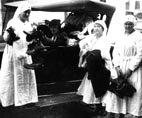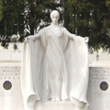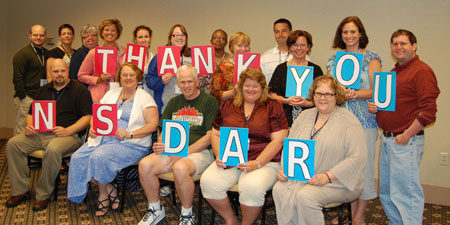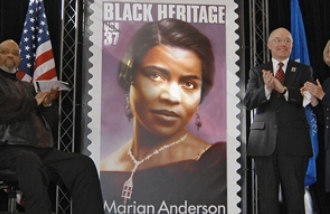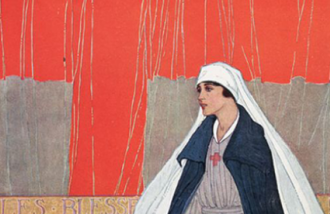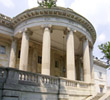Inside This Issue
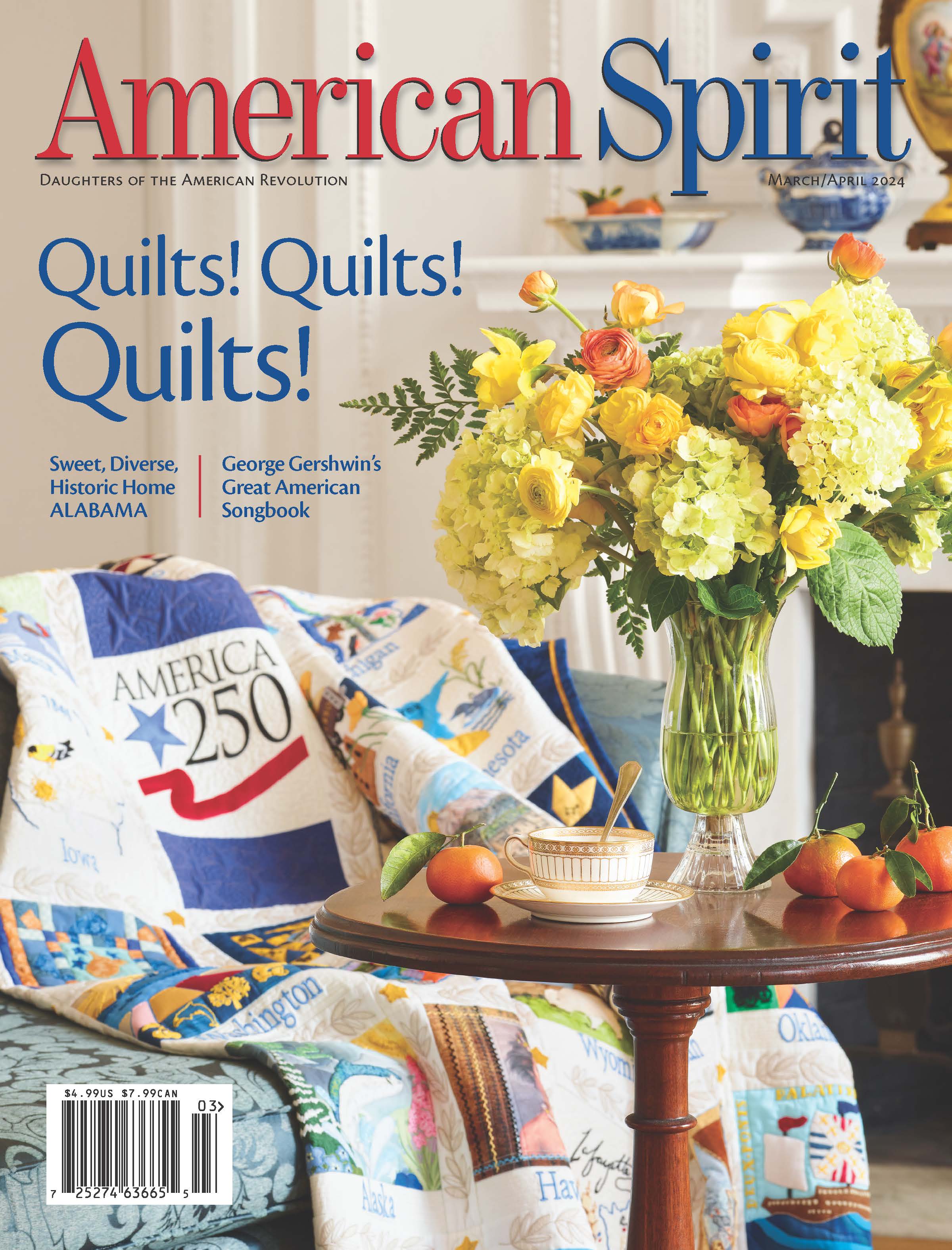
March/April 2024
Glimpse into the lives and passions of the diverse group of women who comprise today’s DAR membership.
More Articles
Learn about the interesting historical articles from this issue.
To Come in Our Next Issue
Preview the exciting stories to be featured in the next issue of American Spirit.
Meet Our Members
On the Road Again
Texas Daughter Beth Szescila shares highlights from her long career on PBS’s ‘Antiques Roadshow.’
By Lena Anthony
For 18 years, Beth Szescila participated as an appraiser on PBS’s “Antiques Roadshow.” That means she spent 18 summers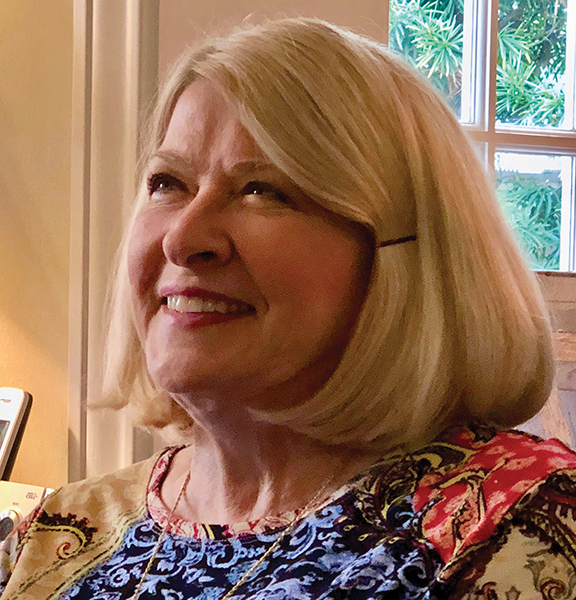 crisscrossing the country, sizing up the prized possessions belonging to thousands of everyday people. During her time on the show, she valued decorative arts and textiles, including outfits of famous celebrities Marilyn Monroe and Elvis Presley. But her fondest finds were antique quilts.
crisscrossing the country, sizing up the prized possessions belonging to thousands of everyday people. During her time on the show, she valued decorative arts and textiles, including outfits of famous celebrities Marilyn Monroe and Elvis Presley. But her fondest finds were antique quilts.
An on-again, off-again quilter since childhood, Ms. Szescila specializes in the tedious, time-consuming art of hand quilting, a skill her mother taught her as a child. That is why any time an old quilt came across her “Antiques Roadshow” table, Ms. Szescila would take a special interest.
“I love antique quilts because if they’ve survived this long and they’re in good condition, that means someone loved and cared about them,” said the member of Alexander Hodge DAR Chapter, Sugar Land, Texas. “It can also say a lot about how well that quilt was made and how the people it was made for felt about it.”
Take, for example, the lace quilt a man presented to her for appraisal. His mother, grandmother and aunt had saved lace for years. Because there was no daughter in the family, they made him a quilt as a wedding gift. “Instead of the expected wedding dress, they made this quilt together, which is such an important quilting tradition,” Ms. Szescila said. “It was a labor of love for him, which I thought was really sweet.” Sentimental value: priceless.
Another intriguing piece was a circa 1903 quilt featuring a map of Arkansas, including railroads, rivers and county lines. “Visually it wasn’t great, but what was interesting about it was that the state’s western border had changed slightly after Oklahoma became a state in 1907,” she said. Value: $800–$3,000.
One of the most expensive quilts Ms. Szescila appraised for “Antiques Roadshow” was an American Album quilt, which she dated somewhere between 1850 and 1860 based on the fabrics and color scheme. Its blocks featured various skill levels, indicating that several people were likely involved in its construction. Value: $8,000–$10,000.
Outside of her role on the show, Ms. Szescila owned a thriving appraisal business in Houston, specializing in fine art, antiques and residential content. “Most people do not realize that appraisers on ‘Antiques Roadshow’ are not paid for their services or travel expenses,” she said. “The trade-off is that it is an honor to be chosen, and you could not ask for better advertising.”
While appraising can seem like a glamorous job, Ms. Szescila spent most of her time not with the objects themselves but doing research and writing reports. “If you’re going to be an appraiser, you have to really enjoy research,” she said. “That’s about 99% of the job.”
Retired since 2013, Ms. Szescila finds herself still doing lots of research, but of a much different kind. “Since joining the DAR, I have really gotten really into genealogy,” she said. “I guess the research part of my appraisal career is there now.”
In retirement, Ms. Szescila fills a lot of her time creating art—in forms as varied as the ones she appraised on “Antiques Roadshow.”
During the pandemic, she finished a quilt she started for her son in 1988 and put aside for two careers. “If I used a machine, it would have taken a few hours to quilt, but because it was hand quilted, it took hundreds of hours,” she said. She also crochets nests for orphaned baby wildlife through the Wildlife Rescue Nests program. She also has taken up wildlife photography and is painting again.
“I live on a lake and see a lot of shorebirds and deer that come by every day,” she said. “I’m so blessed to live in a place where I have such a beautiful view.”
Best in Show
Award-winning quilt artist Nancy Prince uses fabric and thread to reimagine American masterpieces.
By Lena Anthony
When Nancy Prince saw John Trumbull’s “Declaration of Independence” painting on display during a high school field trip to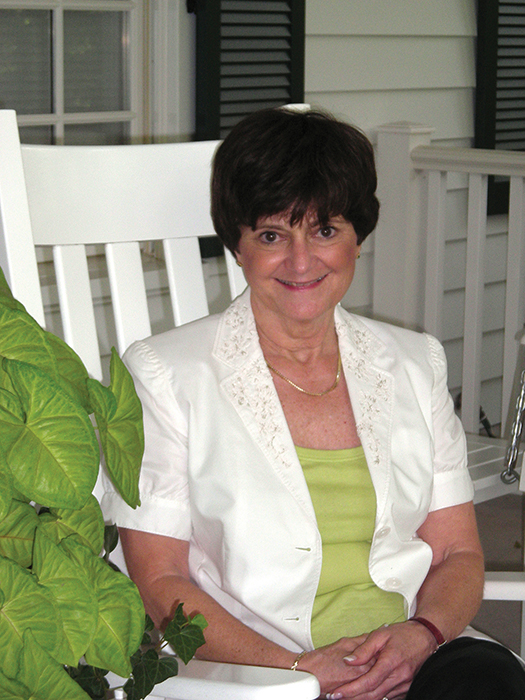 the U.S. Capitol, she thought, “That would make an interesting quilt.”
the U.S. Capitol, she thought, “That would make an interesting quilt.”
Mrs. Prince began sewing at the age of 13. She took up quilting in the 1990s but disliked the repetition required of traditional patterns. One hiking trip to the Great Smoky Mountains and one photograph of a waterfall later, and she had stumbled upon a different technique—one that has kept her attention ever since.
“I wanted to make a memento of our trip, and so I tried to put the waterfall onto a quilt,” said Mrs. Prince, a member of William P. Duval DAR Chapter, Winter Park, Florida. “I did a zigzag stitch over the water to give it a little movement.”
She did not get it exactly right, but she got it right enough that she wanted to keep trying her hand at the technique. “When I was looking for books to help me, I realized it had a name: thread painting.”
Moving from landscapes to animals and people, she racked up awards and Best in Show accolades all along the way. In 2017, Mrs. Prince started her “Voices of Freedom” thread painting, transforming Trumbull’s signers of the Declaration from oil on canvas to polyester thread on fabric.
Measuring 95 inches by 65 inches, with more than 11 million stitches and 95,000 yards of thread, the quilt took 4,000 hours over four years to complete (see inset photo). Reproducing the clothing in thread of the 47 men took 14 months. Adding to the complexity was Mrs. Prince’s insistence that her quilt honor the original work—both of Trumbull, who spent more than three decades painting the likenesses of those appearing in the scene, and of the Founding Fathers, who sacrificed their wealth and safety for freedom and liberty. To assure the likeness of each face was the same as Trumbull’s painting, Mrs. Prince spent months of research and practice and a year of actual painting.
Her current project depicts George Washington crossing the Delaware River in December 1776—a scene made famous by the German-American painter Emanuel Leutze. She has been working on it for three years and estimates she will need two more to finish it.
“In an eight-hour day, I might accomplish a small person, but I don’t usually have a full day to quilt,” she said. “I’m working on an arm right now.”
In between her own quilting projects, she teaches others how to master the thread painting technique. Pre-pandemic, her teaching gigs would take her around the country and overseas. These days, she teaches online classes from her quilting studio above her garage at home in Orlando, Florida. She has also authored two books, Simple Thread Painting and Thread Painting With Style.
Mrs. Prince’s pastime turned passion further prompted her to pursue DAR membership.
“DAR was something I always wanted to look into but just never got around to it,” she said. “When I was researching the Founding Fathers, I decided it was time.”
She joined the National Society in 2023 and quickly got plugged into her chapter’s involvement with Quilts of Valor®, a nonprofit that awards quilts to service members or Veterans.
“When I thread painted that first waterfall all those years ago, never could I have imagined all this,” Mrs. Prince said. “Quilting is so much more than a hobby to me. If I’ve got two hours of free time and it’s either watching TV or coming to my studio to work, there’s no competition. Until I draw my last breath, I hope to be in front of a sewing machine.”
America's Treasure
A Grand Spectacle
Soaring knifelike toward the heavens, the enigmatic Teton Range anchors Grand Teton National Park.
By Kim Hill
Legend has it that the Teton Range of mountains was named by 19th-century French-speaking trappers, who called the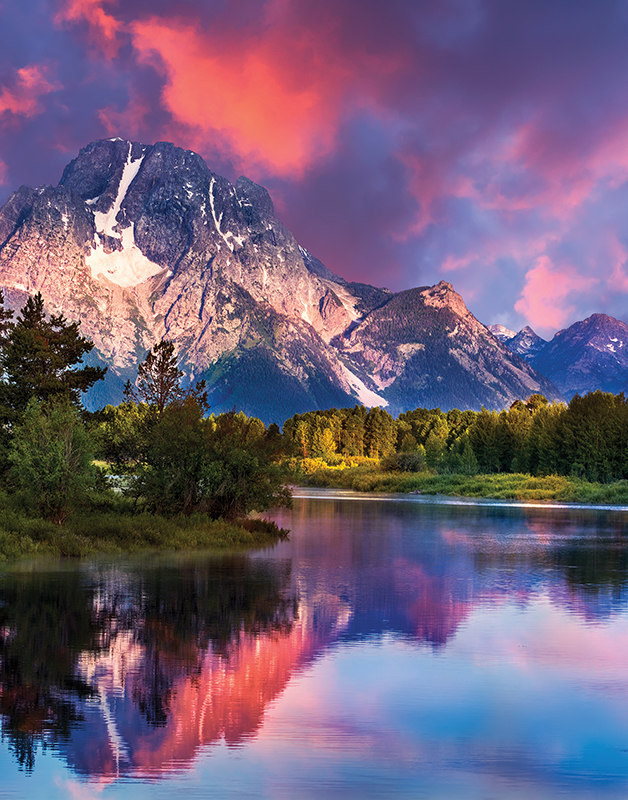 highest peaks “les trois tétons” (the three teats), a phrase later shortened to Tetons. The tallest peak, Grand Teton, lends its name to Wyoming’s Grand Teton National Park (GTNP), home of dramatic mountains, alpine lakes and waterways, and thick forests.
highest peaks “les trois tétons” (the three teats), a phrase later shortened to Tetons. The tallest peak, Grand Teton, lends its name to Wyoming’s Grand Teton National Park (GTNP), home of dramatic mountains, alpine lakes and waterways, and thick forests.
Compared with other mountain ranges in the United States, the Tetons are geologically young. Geological upheaval, retreating glaciers and erosion caused them to rise like knives about 10 million years ago. The striking views of the Tetons from the east are possible because they rise so sharply and because no significant foothills or lower peaks obscure the view.
At more than 13,000 feet, Grand Teton, part of the Cathedral Group of mountains, is the tallest mountain in the Teton Range. As the glaciers retreated, moraines acted as natural dams, forming lakes at the Cathedral Group’s base.
Humans Struggle in and for the Landscape
Evidence of human habitation in the region dates back at least 11,000 years. The Blackfeet, Gros Ventre and Shoshone are among the tribes who spent summers here before heading to warmer climates in winter. Explorers and trappers, such as David E. Jackson, arrived in the 1820s; the valley of Jackson Hole, Jackson Lake and the nearby town of Jackson are named after him. The climate and soil made ranching and farming difficult. Homesteaders realized their best hope for success lay in marketing the area’s magnificent landscape. Dude ranches began appearing in the early 20th century.
In 1897, Colonel S.B.M. Young, the acting superintendent of Yellowstone National Park, proposed expanding Yellowstone’s boundaries to include part of northern Jackson Hole to protect migrating elk herds. In 1898, Charles D. Walcott, the head of the U.S. Geological Survey, suggested that the Teton Range also be included, but the Department of the Interior and Congress ignored these suggestions.
In 1916, National Park Service (NPS) director Stephen Mather and his assistant, Horace Albright, issued a report supporting proposals to include the Teton Mountains and part of Jackson Hole in Yellowstone National Park. A 1918 Congressional bill to expand Yellowstone’s boundaries faced opposition from sheep ranchers, local dude ranch operators and U.S. Forest Service personnel.
After many years, President Calvin Coolidge signed a bill establishing Grand Teton National Park in 1929, but it protected only the major peaks of the Teton Range and six lakes at the foot of the mountains. The valley of Jackson Hole remained privately owned until the 1930s. Local businesspeople and ranchers, alarmed at proposals to dam outlets of area lakes, began to realize NPS protection might be their best hope to protect natural resources. They sought to purchase private lands to create a reserve or recreation area.
John D. Rockefeller Jr., then one of the richest men in the country, had admired the land and scenery in the mid-1920s but was appalled at the shabby tourist developments. He formed the Snake River Land Company to mask his involvement in land purchases. Eventually, he spent about $1.4 million to amass 35,000 acres, intending to donate the land to the federal government. When word got out that Rockefeller was behind the acquisitions, locals protested. Bitter struggles prevailed for nearly 20 years. Finally, Rockefeller threatened to sell the land. In 1943, President Franklin D. Roosevelt used the Antiquities Act of 1906 to create the Jackson Hole National Monument. Local backlash intensified, but a compromise was finally reached. In 1950, Grand Teton National Park’s boundaries preserved about 310,000 acres, including the major peaks of the Teton Range, the upper main stem of the Snake River and much of Jackson Hole.
Read more about the article here.
More Articles
American Artisans: Art of the New Deal by Emily McMackin Dy
Americanism: George Gershwin American Rhythm and Rhapsody by Jeff Walter
America’s Treasure: A Grand Spectacle by Kim Hill
DAR Buildings and Monuments: ‘It Speaks to Your Heart’ by Bill Hudgins
Historic Homes: Revolutionary Residences by Bill Hudgins
Meet Our Members: Best in Show by Lena Anthony
Meet Our Members: On the Road Again by Lena Anthony
My Patriot: Free at Last by Lena Anthony
On the Road to 250!: Stitching the Tapestry of America
President General Profile: Cornelia Cole Fairbanks
Stars & Stripes: Ike’s Cross-Country Road Trip by Jeff Walter
Travel Log: Sweet, Diverse, Historic Home Alabama by Nancy Mann Jackson
Plus: The 250th Anniversary of the Boston Tea Party; All That Sparkles With the President General; DAR Learning Opportunities; DAR Recipe; Genealogy Tidbits; Ideas, Ideas, Ideas!; News From the DAR Committees; Roman Holiday
To purchase an issue of American Spirit, contact [email protected]
To subscribe to American Spirit, visit Subscribe.


